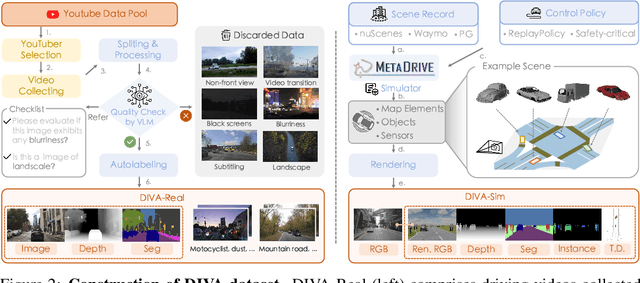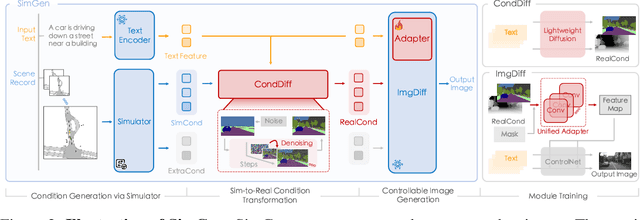Michael Simon
SimGen: Simulator-conditioned Driving Scene Generation
Jun 13, 2024



Abstract:Controllable synthetic data generation can substantially lower the annotation cost of training data in autonomous driving research and development. Prior works use diffusion models to generate driving images conditioned on the 3D object layout. However, those models are trained on small-scale datasets like nuScenes, which lack appearance and layout diversity. Moreover, the trained models can only generate images based on the real-world layout data from the validation set of the same dataset, where overfitting might happen. In this work, we introduce a simulator-conditioned scene generation framework called SimGen that can learn to generate diverse driving scenes by mixing data from the simulator and the real world. It uses a novel cascade diffusion pipeline to address challenging sim-to-real gaps and multi-condition conflicts. A driving video dataset DIVA is collected to enhance the generative diversity of SimGen, which contains over 147.5 hours of real-world driving videos from 73 locations worldwide and simulated driving data from the MetaDrive simulator. SimGen achieves superior generation quality and diversity while preserving controllability based on the text prompt and the layout pulled from a simulator. We further demonstrate the improvements brought by SimGen for synthetic data augmentation on the BEV detection and segmentation task and showcase its capability in safety-critical data generation. Code, data, and models will be made available.
Trustworthy Artificial Intelligence and Process Mining: Challenges and Opportunities
Oct 06, 2021

Abstract:The premise of this paper is that compliance with Trustworthy AI governance best practices and regulatory frameworks is an inherently fragmented process spanning across diverse organizational units, external stakeholders, and systems of record, resulting in process uncertainties and in compliance gaps that may expose organizations to reputational and regulatory risks. Moreover, there are complexities associated with meeting the specific dimensions of Trustworthy AI best practices such as data governance, conformance testing, quality assurance of AI model behaviors, transparency, accountability, and confidentiality requirements. These processes involve multiple steps, hand-offs, re-works, and human-in-the-loop oversight. In this paper, we demonstrate that process mining can provide a useful framework for gaining fact-based visibility to AI compliance process execution, surfacing compliance bottlenecks, and providing for an automated approach to analyze, remediate and monitor uncertainty in AI regulatory compliance processes.
 Add to Chrome
Add to Chrome Add to Firefox
Add to Firefox Add to Edge
Add to Edge